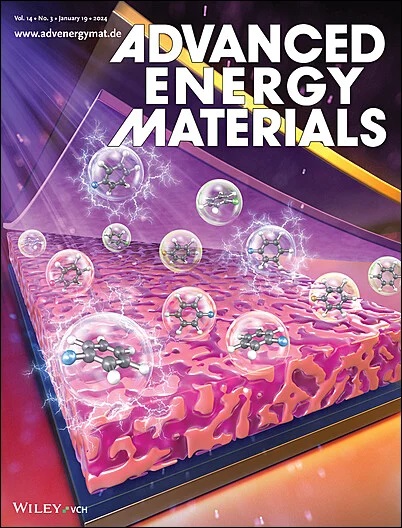Enhanced Redox Kinetics of Aqueous I−/I2/I+ Conversion Chemistry in Hydrated Eutectic Electrolyte Over a Wide Temperature Range
IF 24.4
1区 材料科学
Q1 CHEMISTRY, PHYSICAL
引用次数: 0
Abstract
Due to the continuous I−/I2/I+ redox couples, four-electron zinc-iodine aqueous batteries (4eZIBs) offer a high theoretical capacity of 422 mAh g−1. However, sluggish iodine conversion kinetics and unstable zinc plating/stripping significantly limit their widespread adoption. Here, a cost-effective hydrated eutectic electrolyte enriched with organic cations is developed to enhance the reversibility and kinetics of Zn deposition and four-electron iodine conversion across a wide temperature range. Specifically, the iodophilic choline cation (Ch+), in synergy with glycerol, significantly stabilizes I+ and enhances the redox kinetics of iodine species. Concurrently, the adsorption of Ch+ on the anode surface promotes the uniform deposition of Zn2+. Furthermore, the interaction between eutectic components and water disrupts the hydrogen bond network of free water molecules, thereby enhancing the freeze resistance of the electrolyte. Consequently, the 4eZIBs with optimized hydrated eutectic electrolyte not only demonstrate remarkable cyclability with a low-capacity decay of 0.0016% per cycle over 15 000 cycles but also exhibit excellent temperature adaptability in a wide temperature range from −25 to 40 °C. This work provides new insights into the rational design of high-performance 4eZIBs through the organic cation chemistry and optimized electrolyte structures.

宽温度范围内水合共晶电解质中I−/I2/I+转化化学的增强氧化还原动力学
由于连续的I−/I2/I+氧化还原对,四电子锌碘水电池(4eZIBs)提供了422 mAh g−1的高理论容量。然而,碘转化动力学缓慢和锌电镀/剥离不稳定极大地限制了它们的广泛应用。本文开发了一种具有成本效益的富含有机阳离子的水合共晶电解质,以增强锌沉积和四电子碘转化在宽温度范围内的可逆性和动力学。具体来说,亲碘胆碱阳离子(Ch+)与甘油协同作用,显著稳定I+并增强碘种的氧化还原动力学。同时,Ch+在阳极表面的吸附促进了Zn2+的均匀沉积。此外,共晶组分与水之间的相互作用破坏了自由水分子的氢键网络,从而增强了电解质的抗冻性。因此,具有优化的水合共晶电解质的4ezib不仅表现出显著的循环性能,在15,000次循环中,每循环的低容量衰减为0.0016%,而且在- 25至40°C的宽温度范围内表现出优异的温度适应性。本研究通过有机阳离子化学和优化电解质结构,为高性能4ezib的合理设计提供了新的见解。
本文章由计算机程序翻译,如有差异,请以英文原文为准。
求助全文
约1分钟内获得全文
求助全文
来源期刊

Advanced Energy Materials
CHEMISTRY, PHYSICAL-ENERGY & FUELS
CiteScore
41.90
自引率
4.00%
发文量
889
审稿时长
1.4 months
期刊介绍:
Established in 2011, Advanced Energy Materials is an international, interdisciplinary, English-language journal that focuses on materials used in energy harvesting, conversion, and storage. It is regarded as a top-quality journal alongside Advanced Materials, Advanced Functional Materials, and Small.
With a 2022 Impact Factor of 27.8, Advanced Energy Materials is considered a prime source for the best energy-related research. The journal covers a wide range of topics in energy-related research, including organic and inorganic photovoltaics, batteries and supercapacitors, fuel cells, hydrogen generation and storage, thermoelectrics, water splitting and photocatalysis, solar fuels and thermosolar power, magnetocalorics, and piezoelectronics.
The readership of Advanced Energy Materials includes materials scientists, chemists, physicists, and engineers in both academia and industry. The journal is indexed in various databases and collections, such as Advanced Technologies & Aerospace Database, FIZ Karlsruhe, INSPEC (IET), Science Citation Index Expanded, Technology Collection, and Web of Science, among others.
 求助内容:
求助内容: 应助结果提醒方式:
应助结果提醒方式:


